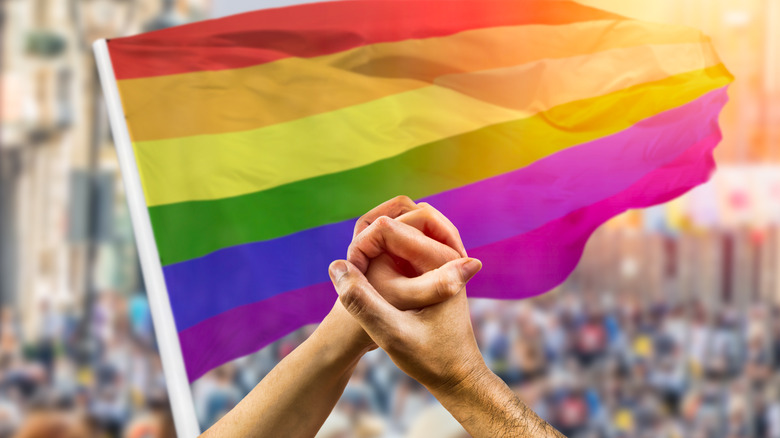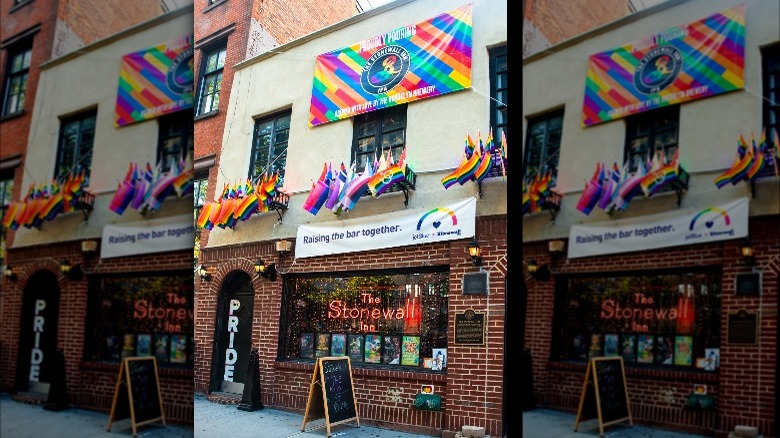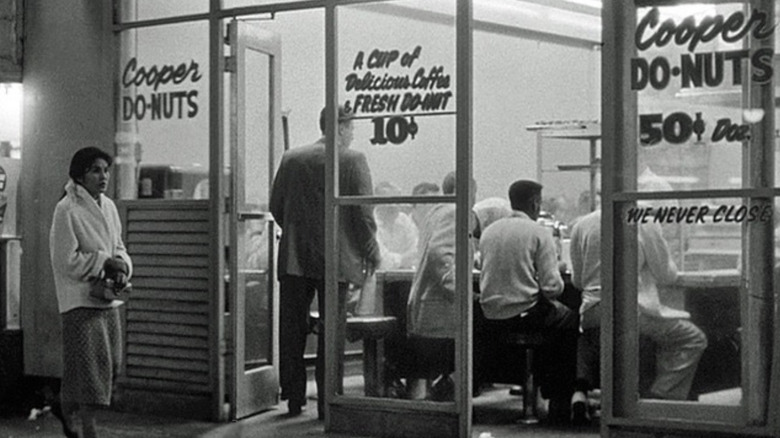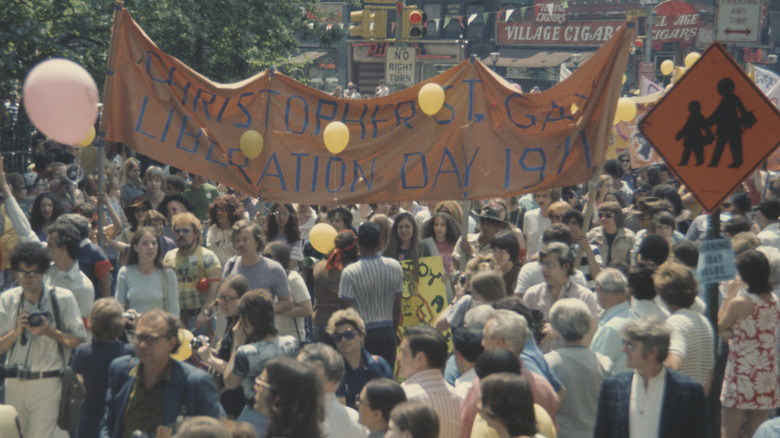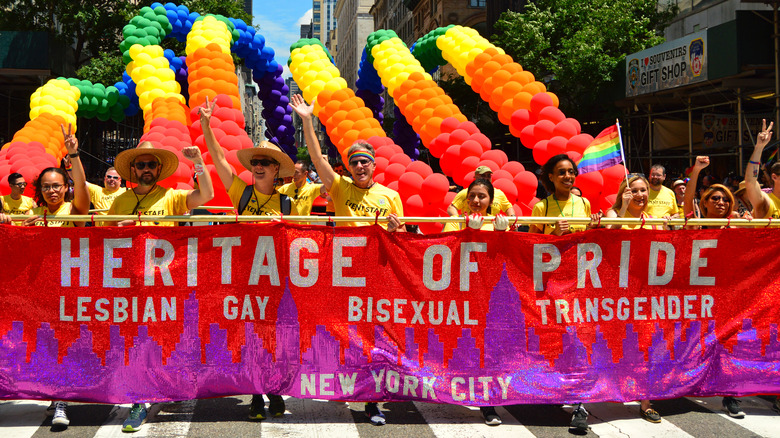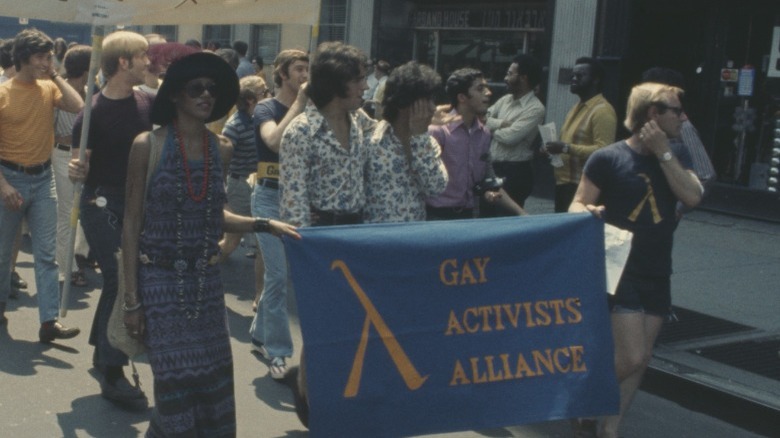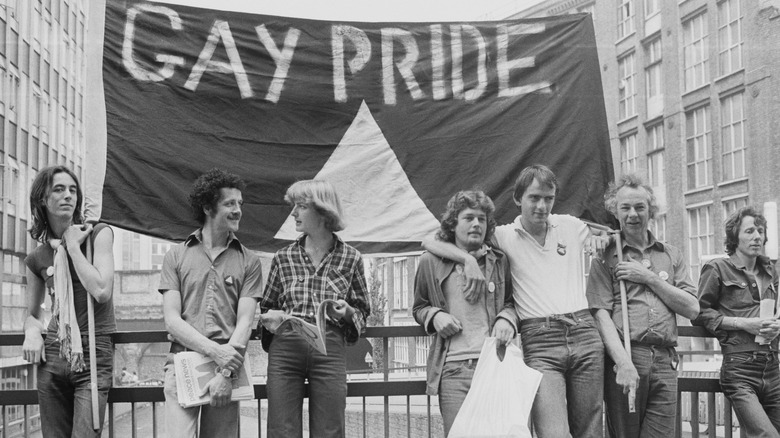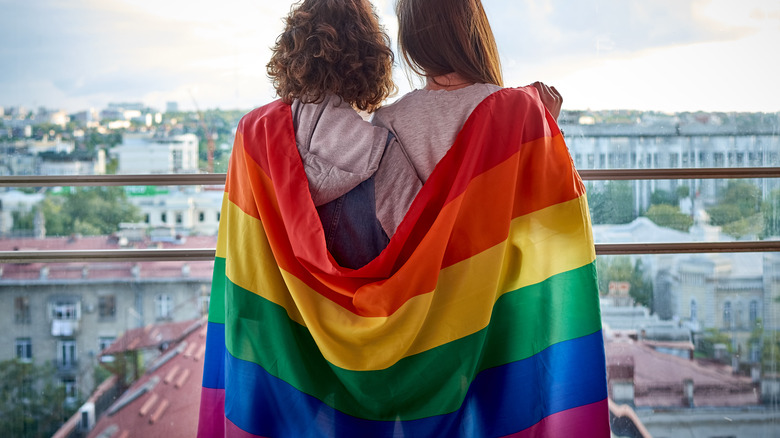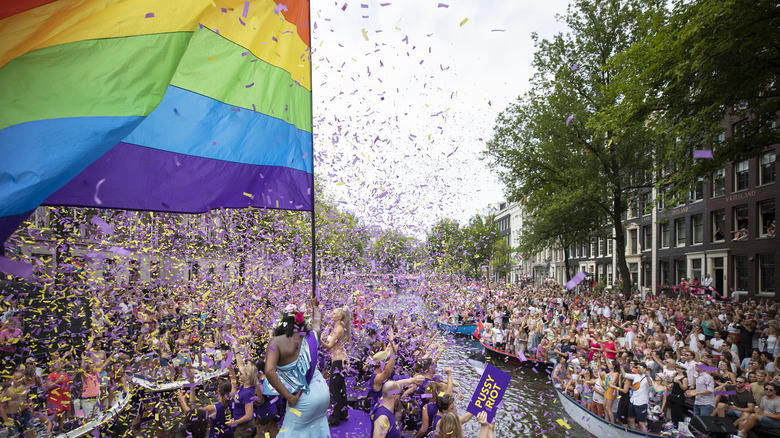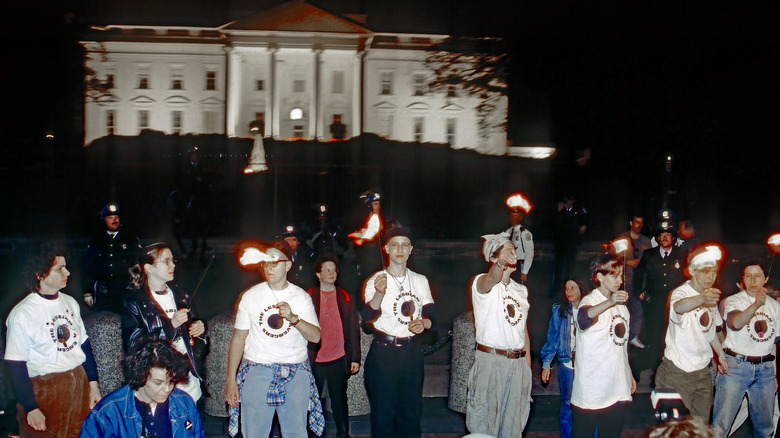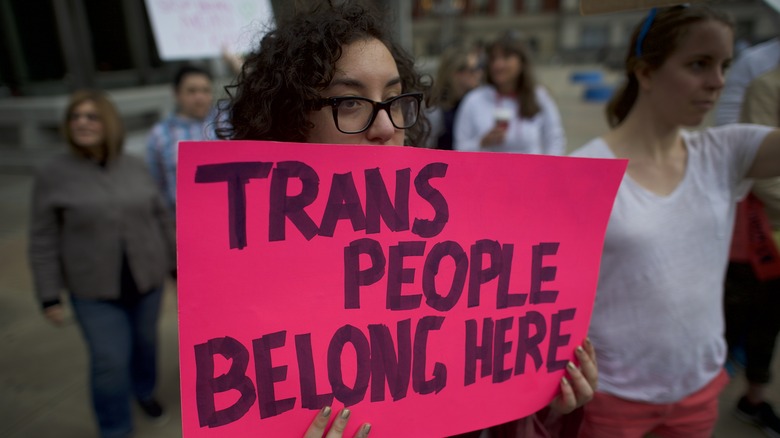What You Didn't Know About The History Of Pride Month
Every summer in the United States, the LGBTQ+ community comes together for a month-long celebration of love, acceptance, diversity, and unashamed self-pride. During June, events for Pride Month in many cities around the world commemorate the progress made toward equality by LGBTQ+ individuals, allies, and supporters worldwide (via Library of Congress). Pride gatherings are embedded in the complex history of minority groups who, for decades, have had to fight to overcome bigotry and be accepted for who they are.
Each year LGBTQ+ Pride Month events draw millions of participants from nationwide (via National Geographic). The festivities and in-person gatherings typically include Pride parades, marches, picnics, parties, concerts, symposiums, and workshops. LGBTQ+ Pride has a long and complex history worldwide with many disregarded or unknown facts. From the origins of the Pride Parade to the meanings behind each rainbow flag color, here are vital facts about the history of Pride Month.
Pride is celebrated in June to honor the Stonewall riot
On June 28, 1969, police raided the Stonewall Inn — a gay club in New York City — for operating without a liquor license. During those years, New York refused to give out permits to bars that served gay people, and that night cops entered Stonewall with a warrant and arrested at least 13 people. Titus Montalvo, a hairdresser and makeup artist in the 1960s, told USA Today that the majority of those people at the Stonewall Inn "were either drag queens or gay men of color."
Raids and harassment were common for gay bars and nightclubs across the country during this time, but on this night, members of the LGBTQ+ community stood up for themselves and fought back. This routine police raid triggered nights of intense rebellion and protests. The Stonewall Inn uprising has long been considered to have fundamentally changed the dialogue surrounding the LGBTQ+ civil rights movement and why many cities hold Pride events in June (via JSTOR Daily).
The Cooper Do-nuts Riot was the first gay uprising
A decade before New York City's Stonewall Riots, a Los Angeles-based group of LGBTQ+ individuals fed up with purported police mistreatment revolted at Cooper Do-nuts, a popular nightspot for groups excluded from other establishments because of their sexual orientation. Historians have long considered that riot the first modern gay community uprising. During the 1950s, the Los Angeles Police Department was long reported to have abused LGBTQ+ residents — even allegedly arresting them for simply gathering at the establishment. "They interrogate you, fingerprint you without booking you: an illegal L.A. cop-tactic to scare you from hanging around," wrote author John Rechy when discussing the abuse by cops in his novel "The City of Night" (via The New York Times).
On that evening in May, two officers allegedly visited the eatery and asked for the identification of several customers, including Rechy. Officers then reportedly proceeded to arrest them without cause. According to Out, patrons who apparently had enough of being oppressed attacked the cops with coffee, donuts, and plates until they had to leave and come back with backup to contain the uprising.
Before there were Pride parades, there were marches
On June 28, 1970, a year after the Stonewall Riot, the first gay liberation march dubbed the Christopher Street Liberation Day March took place in New York City's Greenwich Village neighborhood. People gathered outside the Stonewall Inn on Christopher Street, and groups from all over the country came out to march in unity that day. People from Boston, Washington, D.C., and even organizations from universities such as Columbia, Rutgers, and Yale came to participate in the event (via NPR).
When the transgender community came out to march, however, they were reportedly told by organizers to stand in the back, but they did not comply. Victoria Cruz, a queer, transgender woman and former activist, recalled being shamed into marching in the back on that day over 50 years ago. Cruz stated that members of the transgender community stuck up for themselves because they had fought just like everyone else. They refused to be hidden and, according to Cruz, shouted, "Hell no, we won't go!" while marching alongside everyone else. Cruz noted that all those within the trans community who marched didn't attempt to segregate themselves. A similar march took place the same day in Los Angeles, and just a year later, Boston held their march. After that, gay liberation and pride events took place worldwide, including in cities such as London and Tel Aviv.
Brenda Howard is considered the Mother of Pride
In July 1969, the LGBTQ+ community gathered in New York City for a rally initiated by activist and LGBTQ+ ally Brenda Howard. While Howard herself was not at the bar the night of the riot, she did have friends who were, and after the insurrection, the Bronx native became an advocate for the neighborhood. A year later, Howard formed a committee to plan one of the country's first pride parades: the Christopher Street Liberation Day March. She has also been recognized for laying the foundation for Pride's weeklong festivities that led up to the big modern-day parades that now take place worldwide. Howard was frequently called the "Mother of Pride" for her efforts (via Them).
Howard's support didn't stop with the Christopher Street Liberation Day March. It continued for 30 years, and she became a lifelong revolutionary activist participating in the feminist and antiwar crusades. Howard also participated in the Gay Liberation Front where she served as a chair of the organization. Howard's partner Larry Nelson told The Advocate that she was the go-to person for coordinating a protest or a social justice event and recalled, "All you had to do was call her and she'll just say when and where."
The Greek letter lambda was the original gay rights symbol
The Greek letter lambda was chosen as the gay symbol when graphic designer Tom Doerr and the rest of the New York chapter of the Gay Activist Alliance adopted it in 1970 (via Georgia Tech's Pride Alliance). A flier created by the organization stated that the symbol was chosen to represent "a commitment among men and women to achieve and defend their human rights as homosexual citizens" (via Abe Books). Since the organization sponsored events for the gay community, lambda quickly became a fast and easy way for other gay people to identify with one another. Those within the community also drew the lambda symbol on their outfits and signs, making it easy for the growing gay population to know that a gay event was happening (via QSaltLake).
In 1974, lambda gained international popularity after Edinburgh, Scotland's International Gay Rights Congress officially implemented the symbol.
Craig Schoonmaker is the person behind the phrase Gay Pride
Activist Craig Schoonmaker was a part of the group that came together to honor the Stonewall riots with the Christopher Street Liberation Day March organization. When the committee was thinking of a slogan for their event, Schoonmaker suggested the phrase "Pride." In a 2015 interview with "The Allusionist," the activist spoke about how he conceived the popular slogan. He explained that there were several Pride-themed events taking place during one 1970 weekend, and the group wanted to collect all of the happenings under one label.
Schoonmaker shared that so many people were mightily oppressed during this time and didn't know how to be proud because they were conflicted within themselves. The phrase "Gay power" didn't sit right with him because he felt that not everyone in the world possessed power. However, he did feel they could take pride in themselves. That's when he came up with "Gay Pride." Schoonmaker thought that the feeling of self-esteem would make people more joyful, which in turn would help create the movement with hopes to spark change. According to Schoonmaker, the committee took a vote and decided to call the weekend "Gay Pride Weekend," and added, "That's how the movement was most useful, because they thought, Maybe I should be proud."
Every color of the rainbow flag has a meaning
Over the past four decades, the pride flag has been considered the universal symbol of the LGBTQ+ movement. It's not uncommon to see rainbow flags flying outside bars and homes and pinned to shirts. The flag was designed and hand-sewn in 1978 by late artist and gay rights activist Gilbert Baker. San Francisco City Supervisor Harvey Milk (the first openly gay elected official in California) hired Baker to create a new emblem for the city's first Gay Pride Day. At the time, the gay and lesbian political movement was symbolized by the pink triangle: a Nazi artifact that hailed from the World War II era (via The Gilbert Baker Foundation).
The flag initially consisted of eight colors — all of which Baker assigned meanings. Hot pink represented sex, red for life, orange for healing, yellow for sunlight, green for nature, turquoise for magic, blue for harmony, and violet for spirit. Turquoise and pink were dropped from the six-color flag recognized today because the fabric colors were hard to find at the time for mass production (via Britannica). In 2015, Baker chatted with CNN about the flag and recalled the day of the parade. He stated, "I saw immediately how everyone around me owned that flag. I thought: It's better than I ever dreamed." He also shared his motivation behind the design and explained his community needed something to convey their happiness, splendor, and mightiness. According to Baker, "The rainbow did that."
The Netherlands is home to the world's oldest LGBTQ+ organization
Since 1946, COC Nederland has been fighting for LGBTQ+ rights both nationally and internationally. For more than 75 years, the COC has been lending a hand in supporting LGBTQ+ advocates and continues to petition for the community's fundamental rights. Since the group's inception, it has had some significant achievements, including helping to get the country's General Equal Treatment Act off the ground and officially adopted into law in 1994. The General Equal Treatment Act forbids any person to be discriminated against based on race, religion, age, nationality, religious beliefs, and sexual orientation. During a 2021 interview, Bram Langen — the manager of international programs at COC — told the Government of the Netherlands that while he's very proud that the COC is the world's oldest LGBTQ+ organization, he believes that "it's a shame that after all these years, our work is still so badly needed."
The first Dyke March wasn't until 1993
While the first U.S. Pride Parade took place in 1970, it wasn't until 23 years later that thousands of lesbians would take to the streets in their own march to fight for their rights and visibility. With help from other lesbian organizations, the first march was spearheaded by the New York chapter of The Lesbian Avengers. Thousands of fliers were passed out to spread the word to meet on April 24, 1993, for a "Dyke March to the White House." That night over 20,000 lesbians joined in solidarity and made their way to the National Mall. While in front of the White House, The Lesbian Avengers swallowed fire to draw attention to their group and its cause (via WBUR.org).
After the success in Washington, D.C., the group organized a march in New York weeks later. Atlanta and San Francisco quickly followed suit that summer and hosted their own Dyke Marches.
The first Transgender March took place in 2004
While transgender activists played significant roles in the Stonewall uprising, there still wasn't a defined and singular place for the transgender community to celebrate their identities. In many instances, those within the community faced discrimination even amongst the LGBTQ+ community (via KQED.org). The first march reportedly came about after a mysterious email was sent to community activists in San Francisco. According to Trans March, the email read, "We are calling for this march to demonstrate that we are a significant and growing portion of the LGBTQ community; to increase our visibility and presence in the TGIQLB community and the overall community at large." The anonymous message also encouraged the transgender community to build a connection with one another while speaking against hate, violence, and oppression.
After receiving the message, many activists came together to organize the event. Many local businesses and organizations also chipped in to help make the event a reality (via KQED.org). A few hundred people came together on June 25, 2004, and gathered in Dolores Park to begin the demonstration. Since the first transgender march, the number of attendees has continued to grow, with thousands participating in it annually on the Friday of San Francisco Pride weekend. The event also sparked annual marches, gatherings, and demonstrations worldwide to raise awareness and support of transgender issues.
